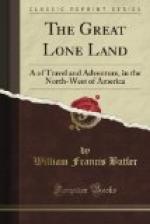La Salle, when he fitted out his expeditions from the Island of Montreal for the West, named his point of departure La Chine, so certain was he that his canoes would eventually reach Cathay. And La Chine still exists to attest his object. But those who went on into the great continent, reaching the shores of vast lakes and the banks of mighty rivers, learnt another and a truer story. They saw these rivers flowing with vast volumes of water from the north-west; and, standing on the brink of their unknown waves, they rightly judged that such rolling volumes of water must have their sources far away in distant mountain ranges. Well might the great heart of De Soto sink within him when, after long months of arduous toil through swamp and forest, he stood at last on the low shores of the Mississippi and beheld in thought the enormous space which lay between him and the spot where such a river had its birth.
The East—it was always the East. Columbus had said the world was not so large as the common herd believed it, and yet when he had increased it by a continent he tried to make it smaller than it really was. So fixed were men’s minds upon the East, that it was long before they would think of turning to account the discoveries of those early navigators. But in time there came to the markets of Europe the products of the New World. The gold and the silver of Mexico and the rich sables of the frozen North found their way into the marts of Western Europe. And while Drake plundered galleons from the Spanish Main, England and France commenced their career of rivalry for the possession of that trade in furs and peltries which had its sources round the icy shores of the Bay of Hudson. It was reserved however for the fiery Prince Rupert to carry into effect the idea of opening up the North-west. Through the ocean of Hudson Bay.
Somewhere about 200 years ago a ship sailed away from England bearing in it a company of adventurers sent out to form a colony upon the southern shores of James’s Bay. These men named the new land after the Prince who sent them forth, and were the pioneers of that “Hon. Company of Adventurers from England trading into Hudson Bay.”
More than forty years previous to the date of the charter by which Charles Ii. conferred the territory of Rupert’s Land upon the London company, a similar grant had been made by the French monarch, Louis XIII, to “La Compagnie de la Nouvelle France.” Thus there had arisen rival claims to the possession of this sterile region, and although treaties had at various times attempted to rectify boundaries or to rearrange watersheds, the question of the right of Canada or of the Company to hold a portion of the vast territory draining into Hudson Bay had never been legally solved.




